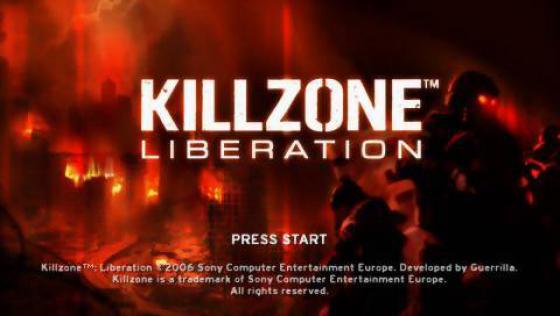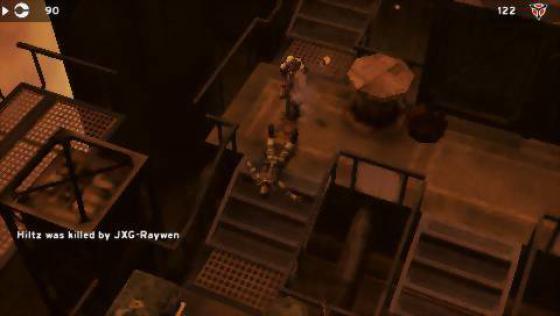
Gaming Age
 31st October 2006
31st October 2006
Author: Jim Cordeira
Publisher: Sony
Machine: PlayStation Portable
Killzone: Liberation
The original Killzone, released on the PS2 a couple of years ago, was once touted as Sony's answer to Halo. While the Guerilla Games-developed title showed a lot of promise, especially in the art, concept and design department, the game was too buggy and incomplete feeling for its own good. Soon thereafter, the game fell off the map... until that fateful '05 PlayStation 3 unveiling, of course. The mind-blowing target rendered trailer of the next-gen "Killzone 3" certainly caught everyone's attention, though a few people were left wondering what exactly happen to part 2. Soon thereafter Killzone: Liberation was announced for the PSP, thus providing the answer to that question.
Killzone: Liberation is a unique title for the PSP. Instead of just porting the PS2 game's engine to the PSP and making a new FPS out of it, the designers over at Guerilla went in another direction - an overhead direction. In a somewhat retro take on the genre, Killzone: Liberation was designed as a overhead/isometric "third person" shooter not that unlike the Commando and MERCS games of old. Surprisingly, the new perspective works extremely well, and as a result the game is easily among the most white knuckle, action packed blast-a-thons that the PSP has to offer.
As with the original Killzone, Liberation's storyline has a bit of a Star Wars "evil empire" feel to it. It's difficult to craft a deep storyline to go along with an action shoot-em-up of this type, though Guerilla does just enough to keep you interested all the way through. Two months after the events of Killzone, most of southern Vekta is still under Helghast control. The rules of war have been cast aside with the Helghast General, Metrac, employing brutal measures in order to seize the initiative and strengthen his position further. Returning as Templar, players will be sent on a mission to undertake a covert operation to save hostages captured by Metrac, while ISA troops continue the fight for liberty.
At first glance, Killzone appears to be set in a somewhat boring, colorless world that looks like, obviously, a war-torn battlefield. The game takes place over 5 chapters, each with several missions spanning various locations. Although the environments range from destroyed cities, to swamps, to hidden military bases, the setting does not change all that much throughout the game. The look and feel remains somewhat consistent, though the environments all are well-designed and unique, with tons of detail and very little repetition of features. Even though the game plays out in a zoomed out perspective, there is no shortage of details and effects to please the eyes. Smoke and debris are constantly erupting among the surface, and explosions and gunfire kick up a satisfying amount of sparks and particles. As compared to a FPS, the characters are of course on the small side thanks to the overhead camera. That apparently didn't matter much, because Guerilla still went all out with the motion captured animations and rag-doll physics. The game also features a number of real-time cut scenes which show off a bit more of the details found in both the characters and the environments. Overall, Killzone is an impressive looking game, especially for a portable system.There is no "soundtrack" in particular in the game. The title and menu screens have music, though the game, with the exception of some key points and cut scenes, really does not. Killzone: Liberation does feature fully voiced characters and dialog (for friends and enemies) and it's actually pretty decently acted. Killzone makes up for the lack of in-game music with layers and layers of ambient sound effects. Ear-ringing explosions in the distance, a strong windstorm blowing through the canyon below, the crackling of burning battlefield artillery, for example, do a good job in filling out audio aspect.
Killzone: Liberation is not an easy game. While it is possible to stay under the radar and out of sight to an extent, Killzone is all about the gunfights. The enemy Helghast soldiers puts up an amazingly good fight and even intelligently works as a group to flush you out and take you down. They also seem to change up their tactics and keep you guessing. While the game plays out in the overhead perspective, it still "feels" like a FPS, thanks to the various gameplay tactics needed to survive. Besides running and gunning, you can lock onto enemies, crouch to take more accurate shots, take cover behind various objects, perform a close-up melee attack and pull out a defensive roll. There is no way to actually jump. The auto lock-on scheme which requires you to be within "weapon sight" and distance of an enemy takes some getting used to, and even then it still occasionally freaks out here and there. It's nothing game breaking, and there were only a handful of times during the frequent bouts of chaos that I could describe as frustrating.
The developers also found a way to work in some strategic co-op play with friendly soldiers and the occasionally escorted civilian. With a tap of the d-pad, you can simply order your buddy to move to a certain location, take cover, or attack a particular enemy. There are not many instances where this scenario comes into play, though there are a few knock down, drag out battles when the extra help is definitely required.The primary weapons, ranging from assault rifles, to a revolver and chain gun, to of course, a rocket launcher, are all a fairly realistic take on futuristic weaponry. There are no laser beams or strange alien technology found anywhere within the game. Your character can only carry one primary weapon, and one secondary weapon (grenades, mines, etc.) at a time, which can be swapped/refilled at various weapon lockers scattered about the battlefield. I actually very much like the weapon restriction implemented in K:L, as it makes the game much more strategic.
Guerilla also saw fit to include a few useable vehicles, such as a tank, a hovercraft and even a jetpack. When I say "a", however, I mean it literally. The vehicles are awesome, but throughout the entire game you get to use each of them exactly once - which is pretty disappointing.
While Killzone: Liberation is indeed a difficult game, Guerilla worked in a useful auto-save and checkpoint feature which does a great job in eliminating potentially annoying restarts. Certain battles and checkpoints can take several minutes to clear, and there are at least a few times where you'll just make it by the skin of your teeth and be thankful that the game remembered your progress. There are only a couple of boss-style fights in the game, and they are few and far between. The out-of-the-box, single player experience is of moderate length, and will keep most gamers busy for an estimated 8 - 10 hours. Once completing a stage, the only real reason to go back would be to locate any hidden cases of Vektan Dollars that you may have missed, which can then used to unlock enhanced versions of your primary weapons. If you take it fairly slow and keep your eyes peeled, it's not that difficult to locate them all on the first run through. Besides the single player Story Mode, Killzone also has a Challenge Mode, which is comprised of several (surprisingly addictive) mini-games of sort that allow you to earn other abilities such as increased armor, faster bomb disarming, or additional stocks of grenades/mines. Finding the hidden Vektan Dollars in the Story Mode, and playing through these Challenge Mode are really a must, as the game becomes too difficult to progress without some sort of enhancements.Killzone: Liberation is outfitted with a number of multiplayer modes, such as co-op and Vs. modes, for teams or individual players. While the modes are a lot of fun, and well thought out, they are only playable via the local Ad-Hoc mode at the moment. Thankfully, Sony plans on releasing an downloadable Infrastructure module that will allow you to play online. Why this was not included by default, we have no idea, though it knocks down the potential of multiplayer for now. If we had to guess, we'd probably say it has something to do with the launch of the upcoming PS3/PSP PlayStation Network later in November. Some really cool online features did actually make it into the game. From within the game, you can access Killzone.com to perform a number of actions including downloading new game content and missions, constructing your profile, maintaining friends lists, and tracking your own personal achievements. SCEA has confirmed that a whole new Story Mode chapter, including several missions, is scheduled to be made available in the very near future along with the Infrastructure module.
As different as they may be, Killzone: Liberation serves as the perfect transition between the original PlayStation Killzone and the forthcoming PlayStation 3 title. The lack of proper online play is a downer, and in spite of the difficulty, the game could have been a bit longer "out of the box". But overall, the game is an intense shooter with a gritty, cohesive sense of style and direction, and I can't see many fans of the genre being disappointed with it.
Other PlayStation Portable Game Reviews By Jim Cordeira
Scores
PlayStation Portable Version| Overall | 67% |















